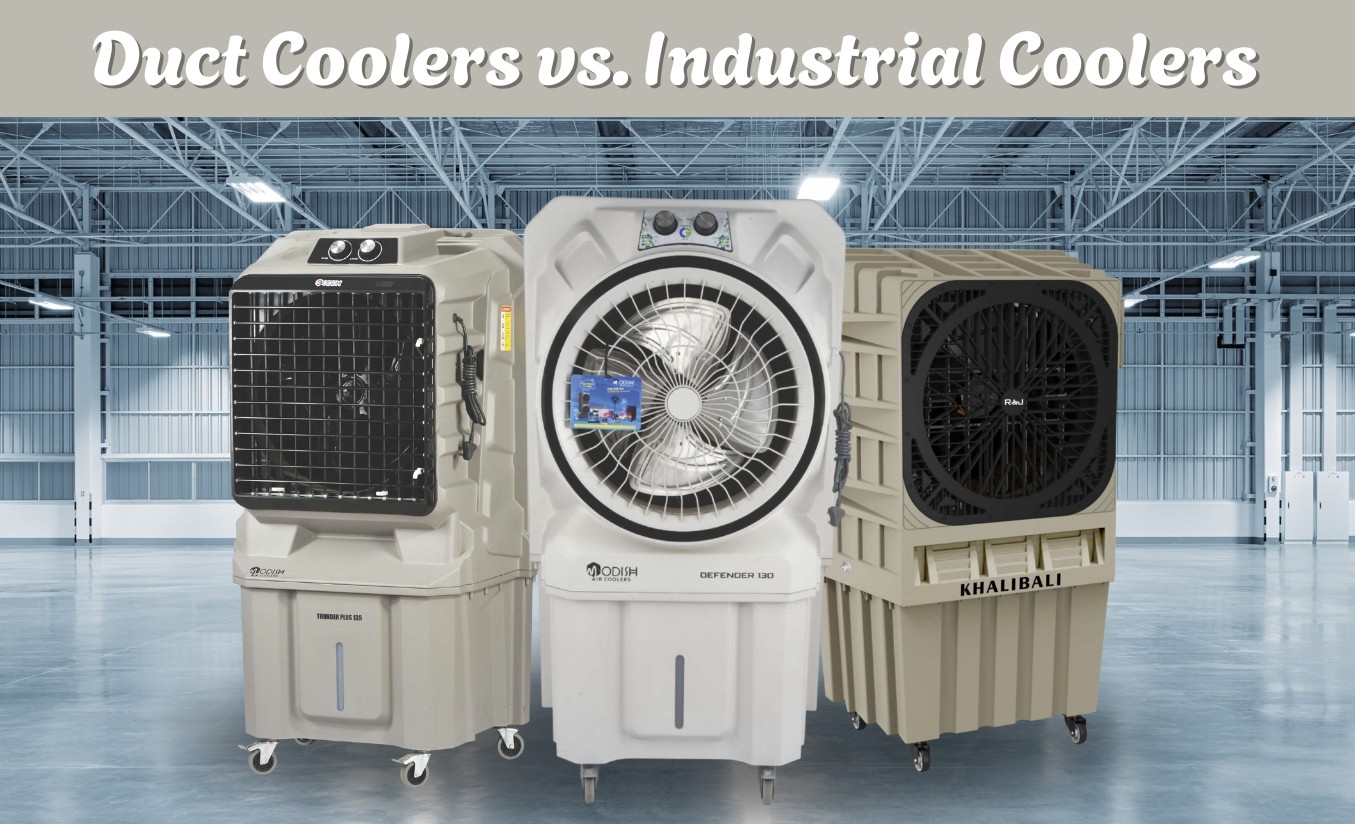Duct Coolers vs Industrial Coolers
Selecting the right cooling system is crucial when it comes to cooling large spaces such as factories, warehouses, and commercial units. Businesses often compare duct coolers vs. industrial coolers to determine which option best suits their operational needs. While both systems are designed to regulate indoor temperatures and improve air circulation, they differ in terms of functionality, structure, and application.
Choosing the Right Cooling Solution for Your Business
At Modish Home Appliances, we specialize in providing high-quality cooling solutions to meet industrial and commercial requirements. Understanding the key differences between duct coolers and industrial coolers can help businesses make an informed decision that impacts energy efficiency, operational costs, and workplace comfort.
What Are Duct Coolers?
How Duct Coolers Work
Duct coolers utilize evaporative cooling technology to lower temperatures by passing warm air through water-saturated pads. The cooled air is then distributed through a network of ducts, ensuring uniform cooling across multiple areas within a building.
Key Features of Duct Coolers
1. Centralized Cooling
Duct coolers work by distributing cooled air through a network of ducts, ensuring that different areas receive a consistent and comfortable temperature. This centralized approach is particularly beneficial for large spaces where direct cooling from a single unit may not be sufficient.
2. Energy-Efficient
Compared to traditional air conditioning systems, duct coolers consume significantly less electricity—up to 80% less. They rely on water evaporation for cooling rather than compressors, making them an excellent choice for reducing energy bills.
3. Cost-Effective Installation
Installing a duct cooler requires minimal modifications to existing infrastructure. Unlike air conditioning systems that need complex ductwork and high-capacity electrical setups, duct coolers can be integrated into existing ventilation systems with ease, making them an affordable cooling solution.
4. Eco-Friendly Operation
Duct coolers use water as their primary cooling medium instead of harmful refrigerants such as CFCs and HFCs, which contribute to global warming and ozone depletion. This makes them an environmentally friendly option for cooling large spaces.
Best Uses of Duct Coolers
1. Large Factories with Multiple Workstations
Factories often have multiple production units and workstations that generate heat. Duct coolers help maintain a comfortable temperature by ensuring even air distribution, improving worker productivity, and reducing the risk of heat-related health issues.
2. Warehouses Needing Uniform Airflow
Warehouses store large quantities of goods, many of which can be sensitive to high temperatures and humidity. A duct cooler helps in maintaining a stable environment, preventing product damage, and ensuring a comfortable workspace for employees.
3. Workshops and Assembly Lines Where Overheating Is a Concern
Workshops and assembly lines involve heavy machinery, which generates significant heat. Duct coolers help in keeping these spaces well-ventilated, reducing equipment overheating and creating a comfortable working atmosphere.
4. Open-Plan Commercial Spaces and Offices
In commercial buildings, duct coolers offer an efficient way to maintain a pleasant indoor climate without excessive energy consumption. They are ideal for large office spaces, shopping centers, and public areas where traditional air conditioning may not be practical or cost-effective.
Would you like me to refine this further or add any specific details?
What Are Industrial Coolers?
How Industrial Coolers Work
Industrial coolers operate similarly to duct coolers but are designed for larger-scale applications. These standalone units generate high airflow and are often used for direct cooling in specific areas.
Key Features of Industrial Coolers
1. High Airflow Capacity
Industrial coolers are designed to deliver powerful airflow, making them ideal for large and open spaces. Unlike residential or office air coolers, these units can push large volumes of air over long distances, ensuring efficient cooling in areas with high heat loads.
2. Portable or Fixed Units
Industrial coolers come in two main types:
A). Portable Models
Equipped with wheels, these can be moved easily to different locations, making them ideal for dynamic work environments.
B). Fixed Units
Installed permanently, these are suited for locations where consistent cooling is required, such as assembly lines or manufacturing plants.
3. Best for Open Spaces
Unlike traditional air conditioning, industrial coolers work best in spaces with good ventilation. They are commonly used in places like:
- Manufacturing units with heavy machinery that generates heat.
- Loading docks where doors remain open, makes traditional cooling systems ineffective.
- Large factories where maintaining a comfortable temperature is essential for worker safety and productivity.
4. Lower Initial Costs
Industrial coolers are more cost-effective to install compared to centralized air conditioning systems. Since they do not require extensive ductwork, piping, or insulation, businesses can save significantly on setup costs while still achieving efficient cooling.
Best Uses of Industrial Coolers
1. Factories with Expansive, Open Spaces
Factories often have high ceilings and large areas that need cooling. Industrial coolers efficiently circulate air, ensuring that workers in different sections receive consistent airflow.
2. Manufacturing Units with High Heat-Generating Machinery
Industries such as metal processing, food production, and heavy engineering involve machinery that produces intense heat. Industrial coolers help maintain a safer and more comfortable working environment by providing constant fresh air circulation.
3. Outdoor or Semi-Outdoor Workspaces
For businesses operating in warehouses, loading bays, or open workshops, industrial coolers offer an effective solution. Since these spaces often lack walls or enclosed structures, conventional cooling systems are impractical, whereas industrial coolers work well even in open-air environments.
4. Automobile Workshops, Foundries, and Textile Mills
A). Automobile workshops
Mechanics and technicians work in high-temperature conditions due to welding, painting, and engine repairs. Industrial coolers help reduce heat stress.
B. Foundries
These facilities handle molten metals, generating extreme heat. Industrial coolers help in cooling workers and preventing overheating of equipment.
C). Textile Mills
The fabric manufacturing process generates significant heat and humidity. Industrial coolers help maintain optimal working conditions, preventing fabric damage and ensuring worker comfort.
Key Differences: Duct Coolers vs. Industrial Coolers
| Feature | Duct Coolers | Industrial Coolers |
| Cooling Type | Centralized cooling via ducts | Direct cooling for specific areas |
| Best For | Large buildings with multiple zones | Open or semi-outdoor spaces |
| Energy Usage | Lower power consumption | Higher airflow but slightly more energy use |
| Installation | Requires ductwork installation | No ductwork needed |
| Flexibility | Fixed system | Can be portable or fixed |
Market Trends in Industrial Cooling
With increasing industrial growth and rising temperatures, businesses are actively searching for energy-efficient and cost-effective cooling solutions. Evaporative cooling technology, such as duct coolers and industrial coolers, is gaining popularity due to its low power consumption and reduced carbon footprint.
Key industry trends include:
- A shift towards eco-friendly cooling solutions that comply with green building standards.
- The integration of smart cooling technologies with remote monitoring and automated temperature control.
- Businesses opt for hybrid cooling setups, combining duct coolers and industrial coolers for optimal efficiency.
Expert Advice: Which Cooling System Is Right for You?
- If your facility requires uniform cooling across multiple sections, duct coolers are the best choice.
- If you need spot cooling for large-scale machinery or open areas, industrial coolers provide better performance.
- A hybrid setup combining both coolers can maximize cooling efficiency and cost savings.
At Modish Home Appliances, we offer a wide range of high-quality duct and industrial coolers tailored to meet your business needs.
Contact Us
Contact us today to find the perfect cooling solution for your facility! For inquiries and expert consultation, reach out to us at:
📞 +91 78678 66869
📧 modishenterprisess@gmail.com
Follow us on Instagram for the latest updates and offers: @modishhomeappliances


